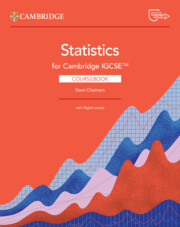Cambridge IGCSE™ Statistics Digital Coursebook (2 Years)
Overview
This digital coursebook will help your students build a confident working knowledge of concepts in probability and statistics. Students will develop their data literacy skills by using statistics in real-world contexts and analysing the results of statistical techniques. A wide range of activities provide opportunities to practise applying key statistical methods and measures, such as sampling, linear interpolation and standard deviation. Help your students prepare for further study by providing opportunities to display their practical skills, such as selecting an appropriate statistics technique for a given scenario. Suitable to support the Cambridge IGCSE™ Statistics syllabus (0479) for examination from 2027.
Features
- Varied exercises throughout each unit encourage students to practise key skills in real-life contexts.
- Worked examples demonstrate the process of a specific task and provide examples of data interpretation, offering an ideal problem-solving structure to support students.
- Investigation tasks enable students to further enhance their knowledge by exploring key concepts in more depth.
- 'Discussion' feature encourages students to talk about what they have learnt and consider different techniques and interpretations of statistics.
- 'Self-assessment' feature encourages students to think about how they have approached each task and consider their level of understanding.
- 'Reflection' feature helps students consolidate their learning and consider how they could improve further.
- Self-evaluation checklists, with 'I am able to' statements linked to the learning intentions, help students review their knowledge.
- Support for English as a second language (ESL) learners with highlighted key words, supporting illustrations, and a clear language of instruction.
- Additional support for planning and teaching with the 'Getting started' feature, which helps you assess what students already know about each topic.
- Useful formula is highlighted next to exercises where it may be used to aid calculations and tips are included to guide students through key topics.
- Accessibility Information: This publication meets the requirements of the EPUB Accessibility specification with conformance to WCAG 2.2 Level AA.
Contents
- Introduction
- Chapter 1 Data and its Collection
- 1.1 Types of data and variable
- 1.2 Surveys
- 1.3 Types of Sample
- Chapter 2 Basic Probability
- 2.1 Experiments, Outcomes and Events
- Chapter 3 Frequency Distributions of Ungrouped Data
- 3.1 Tabular representation
- 3.2 Pictorial Representation
- 3.3 Venn diagrams
- Practice Questions
- Chapter 4 Frequency Distributions of Grouped Data
- 4.1 Grouped Discrete Data
- 4.2 Continuous Data
- 4.3 Pictorial representations
- Chapter 5 Measures of Central Tendency
- 5.1 Measures for Ungrouped Data
- 5.2 Measures for Grouped Data
- 5.3 Features of the Measures of Central Tendency
- Chapter 6 Weighted Averages
- 6.1 Weighted means
- 6.2 Index Numbers
- 6.3 Crude and Standardised rates
- Practice Questions
- Chapter 7 Measures of Dispersion
- 7.1 Range
- 7.2 Interquartile Range
- 7.3 Linear Interpolation from a Cumulative Frequency Table
- 7.4 Standard Deviation and Variance
- 7.5 Features of the Measures of Dispersion
- Chapter 8 Transformation of Data Sets
- 8.1 Derived Distributions
- 8.2 Scaling
- Chapter 9 Probability and Probability Distributions
- 9.1 Mutually Exclusive Events
- 9.2 Independent events
- 9.3 Conditional probabilities
- 9.4 Dependent events
- 9.5 Probability distributions and Expectation
- Practice Questions
- Chapter 10 Bivariate Data
- 10.1 Correlation and Scatter Diagrams
- 10.2 Lines of best fit
- Chapter 11 Time Series
- 11.1 Variation and Trend in a time series
- 11.2 Seasonal Variation, trend line and moving averages
- 11.3 Seasonal Adjustment
- Practice Questions
- Answers to Exercises and Practice Questions
- Glossary
- Index
Brighter Thinking Blog
Keep up to date with the latest classroom tips and educational trends from our brighter thinkers.
Visit the blogCatalogues and Ordering
Looking for something in particular or just browsing? View our catalogues to see our full range of print and digital books.
View and downloadAdvice on useful tools
Advice on useful tools, activities and timetabling from teachers experiencing school closures.
Cambridge GO
All our supporting resources have now moved to Cambridge GO – the new home for your Cambridge digital content.
Listen to our podcast
Listen to our podcast to discover teaching inspiration & advice from leading educational thinkers.




